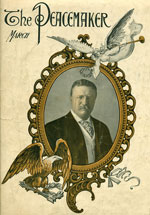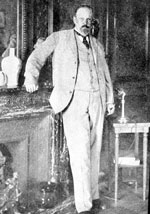 LEGACY
LEGACY

Legacy of the Portsmouth Peace Treaty, Part One
Upon one thing all the envoys and their secretaries, and all the inhabitants of Portsmouth were agreed, — the principals were there to make peace. The onlookers hoped and prayed for peace. It may be safely said that there was no war party in Portsmouth. -- Louis E. Van Norman, "The Making of a Modern Peace Treaty," North American Review, October 1905.
The United States and Roosevelt
In the October 1905 The American Monthly Review of Reviews, Louis Van Norman wrote “The American people and Theodore Roosevelt should be grateful to the Russo-Japanese war for one thing at least. It has furnished us as a nation, and our President as a chief magistrate, an opportunity to demonstrate that we are an intensely peace-loving nation, and that the man with the ‘big stick,’ the man who has been accused of ostentatious bluster, — who, we have been told, was fairly aching to embroil us with the rest of the world, — is really a peacemaker. It is probable that Theodore Roosevelt will be known in history, not for his charge up San Juan Hill, but for his brave and high-principled efforts in bringing about the peace between Russia and Japan.”
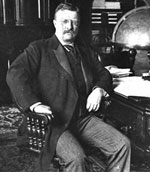
President Roosevelt said the peace was good for Japan, good for Russia, "and mighty good for me too." C. B. Doleac collection. View larger image.
Van Norman was prophetic. In 1906, Roosevelt became the first American to receive the Nobel Peace Prize due to his efforts in facilitating the peace between Russia and Japan. It might be assumed that peaceful relations between the United States and Japan would continue to grow, but the opposite happened. Some Japanese blamed Roosevelt whose interference, they said, prevented Japan from receiving a Russian indemnity. Racial tensions were high in the United States, especially in California, because of the influx of Japanese and Chinese immigrants. Secretary of State Elihu Root and Ambassador Takahira prepared an agreement to resolve differences. Both countries pledged to maintain the status quo in the Far East; recognized China’s independence and territorial integrity and to continue to support the open door policy; and agreed to consult with each other in the event of Far Eastern crises. Also understood was Japan’s annexation of Korea and dominance in Manchuria. Japan continued to expand its influence in China that was opposed by the United States. Japan and the United States began a long competition in their relationship as they became the dominant powers in the Pacific, a competition that ultimately resulted in World War II.
Russia's Reaction
Before Witte returned home, he learned that the Russian people were disgusted with the final terms. “In St. Petersburg, the war party and the autocracy have not been consoled by Japan’s failure to exact an indemnity,” wrote one reporter. “They only remember Russia’s loss of prestige in Europe as well as Asia, her exclusion from the Pacific seaboard and the cession of what they are pleased to call Russian territory, — the southern half of Saghalien.”
Witte
Despite the resentment that the treaty had created in each country, both the Tsar and the Mikado finally ratified the peace on October 15. Witte was made a Count for his efforts although he was not appreciated at the Court of St. Petersburg, the Russian capital. Following strikes by industrial workers in October 1905, however, Nicholas appointed Witte as chief minister, but replaced him in April 1906.
In retirement Witte wrote his memoirs and continued to express his views on politics. In 1914 he opposed Russian involvement in the First World War and later urged peace negotiations with the German government. Witte died in March 1915. For Russia and Tsar Nicholas II, the war with its military defeats and the loss of half of Sakhalin were major steps in the path that led to the 1917 Russian Revolution and the creation of the communist Soviet Union.
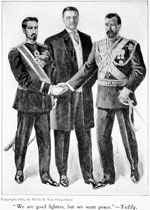
Illustration of Emperor Meiji, Tsar Nicholas, and President Roosevelt. Harper's Weekly. View larger image.
Japan's Short and Long View
In Japan, when it was learned that the country would not receive an indemnity and would be giving up half of Sakhalin, riots broke out. Several people were killed and hundreds were wounded. One mass protest attracted more than one hundred thousand people and there were demonstrations at Christian churches and in front of the homes of Komura and other leading politicians. One Japanese journalist wrote “After eighteen months of war, at the conference at Portsmouth, Nippon has been disgraced by a defeat more serious, more far-reaching in consequences, than the disgrace of ten years ago (following the Chino-Nippon War) ... When the ridiculous disaster of our diplomacy at Portsmouth was made known there was only one newspaper in the whole realm of Nippon that enjoyed the distinction of looking upon the situation as other than a defeat.”
Although many Japanese originally opposed the treaty, the government and the military supported it for, in spite of no indemnity and the loss of half of Sakhalin island, it marked the first time that an Asian nation had confronted a European power, was victorious on the battle field, and essentially dictated the terms of peace. For Japan, the Treaty of Portsmouth is a strong symbol of its emergence as a major power in the community of nations and they are always ready to visit Portsmouth, either to participate in anniversary celebrations or just to sightsee. The fact that Japan gave up its claim for the indemnity and half of Sakhalin Island is viewed today as a magnanimous gesture.
Komura
Komura was sent back to work, negotiating in November 1905 a convention with China based on the terms of the treaty. When the agreements were signed, the government of Prime Minister Taro Katsura resigned. For his services, Komura received the Japanese title of count and was made a K.C.B. by King Edward VII. Later he returned as foreign minister in the second Katsura cabinet. His main assignment was the annexation of Korea, a goal accomplished in 1910, a year before his death. During his second tenure as foreign minister, Komura initated an unusual use of Japanese businessmen to establish business ties with the United States in order to improve relations. An informal approach used to foster formal diplomacy. Komura is now revered in Japan as one of its greatest diplomats.

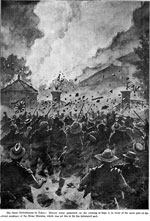
Japanese crowds, unhappy over the treaty rioting, burned streetcars. Harper's Weekly. Click on images for larger view.
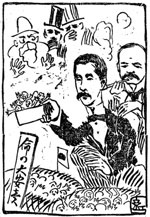
Japanese political cartoon accuses Komura of selling out the dead soldiers because the treaty did not include the indemnity. View larger image.
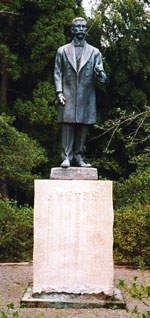
Statue of Komura at Nichinan. C. B. Doleac collection.

